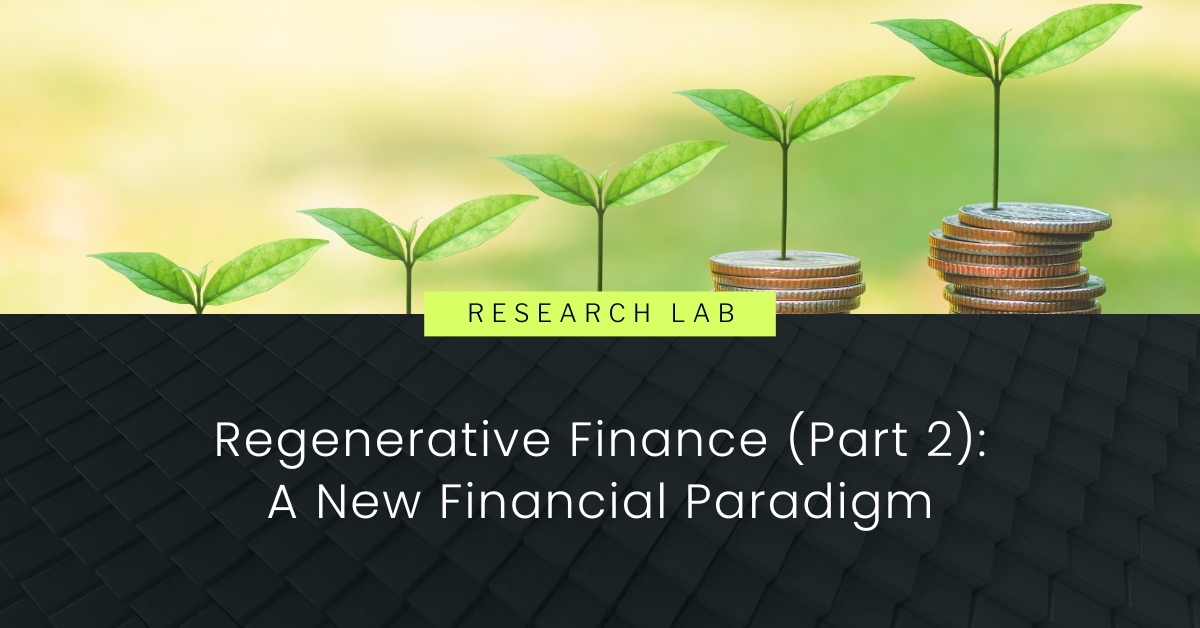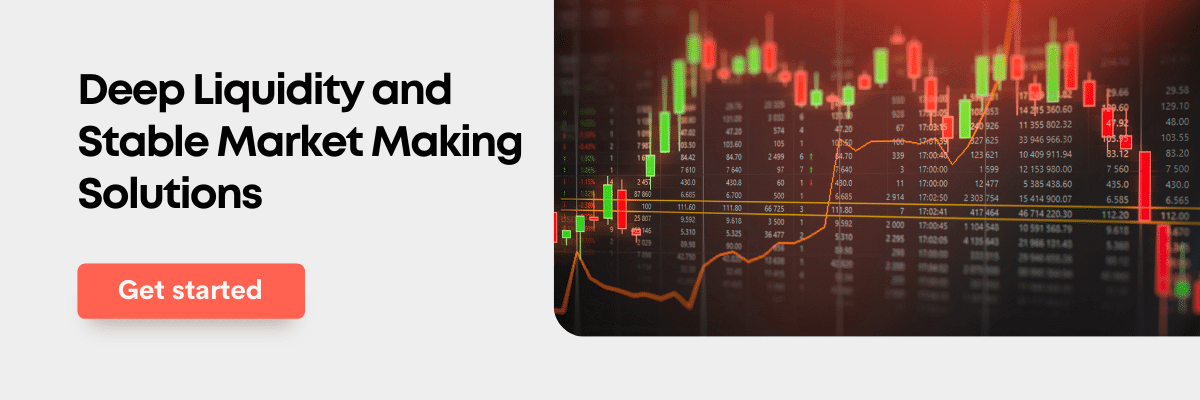Content
- How the Current Financial Environment Could Change
- Funding Public Goods
- Retroactive Public Goods Funding
- About Zerocap
- DISCLAIMER
- FAQs
- What is Regenerative Finance (ReFi)?
- How does Regenerative Finance differ from the current financial system?
- What is Retroactive Public Goods Funding?
- What is the role of Ether's Phoenix in Regenerative Finance?
- What are some examples of projects implementing Regenerative Finance principles?
20 Sep, 22
Regenerative Finance (Part 2): A New Financial Paradigm

- How the Current Financial Environment Could Change
- Funding Public Goods
- Retroactive Public Goods Funding
- About Zerocap
- DISCLAIMER
- FAQs
- What is Regenerative Finance (ReFi)?
- How does Regenerative Finance differ from the current financial system?
- What is Retroactive Public Goods Funding?
- What is the role of Ether's Phoenix in Regenerative Finance?
- What are some examples of projects implementing Regenerative Finance principles?
This is a direct follow-up to Regenerative Finance (Part 1): How it Works and Why it Matters
In Part 2 of 3 for our Regenerative Finance coverage, Innovation Analyst Nathan Lenga covers how financial incentives can be involved in bringing about a regenerative society and what protocols are currently working to innovate in this space.
Stay tuned for Part 3, where Nathan will examine another method being used to encourage the creation and funding of public goods; social incentives.

How the Current Financial Environment Could Change
Currently, we get rewarded for creating value with the incentive of money. More value for the business, more money for us. This is why the Once-ler (mentioned here) continues to cut down the thneeds despite the negative externalities his actions creates – driving the natural habitants out of their territory.
Yet, a world inculcated by ReFi-related ideas would look completely different. Imagine if the Once-ler was monetarily encouraged to plant truffula tufts. Rather than being rewarded for creating value, the Once-ler would be rewarded for putting in value – his time, resources and energy. Simultaneously, those seeking to make a profit by cutting down the Lorax’s trees would be charged for creating this negative externality. All these actions that either advantage or detriment the world would be immutably and transparently recorded on the blockchain. Through this, there would be no doubt that rewards or fines would be handed out according to one’s impact on the world.
This financial system makes use of the same tools humanity currently has, however, focuses on the long-term survival of the species. Those looking for work would no longer make decisions based on a salary. Instead, the most influential factors would include which occupation reduces existential risk, funds public benefits and help humans coordinate to solve global problems. Evidently, trade will remain as free as it is in our current market, yet place an impetus on individuals to think beyond their short-term income.
Funding Public Goods
Every working member of society is already involved in the funding of public goods. Although indirect, our tax money gives us an opportunity to create this positive externality. In Australia, throughout the 2020-2021 financial year, we paid $593.2 billion AUD in taxes. Through paying taxes, Australians gave $161.7 billion AUD to finance health services like hospitals and $40.7 billion AUD to fund the public good of defence forces.
However, despite our funding of public goods through taxes, we are not yet incentivised to pay taxes. We are aware of the benefit and positive externalities created by our funding but in the short term, because many of us receive minimal benefit, we remain resentful. As such, no one gets excited about paying their taxes. ReFi strives to reverse this. ReFi rewards those who focus on the long-term implications of their actions, especially when they benefit the world around them.
Though many public benefits exist outside of the world of crypto, there are also non-excludable and non-rivalrous goods within technology and its infrastructure. One important product that requires funding is the scaling of Ethereum. The societal and economic opportunities heralded in by the 1.5+ million smart contracts existing on the Ethereum blockchain are unparalleled. However, with more than 200 million unique addresses, this crucial blockchain has become less efficient and exorbitantly expensive for users.
Fortunately, the Ethereum community has autonomously made impressive strides in financing the public good of scaling Ethereum. The Gitcoin team has been crusading for an open, scalable web by providing grants to individuals and entities attempting to develop digital public goods. Gitcoin has leveraged donations from companies, including Coinbase ($1 million USD) and Nouns (169 ETH), to support open source projects who are having meaningful impacts on scaling and advantaging Ethereum.
In an attempt to finance ideas based on their prospective impact on digital public goods, Gitcoin provides grants based on quadratic funding. This funding model prioritises democracy by ensuring that donors from all economic backgrounds have an impact in supporting relevant projects. To put it simply, quadratic funding mathematically allocates capital to ideas and platforms depending on how many individuals participated in the funding round. As such, Gitcoin has utilised quadratic funding to match the number of community members donating to the public benefits project as opposed to the total contributed. Through this model, Gitcoin has provided over $64 million USD to support digital public goods on the Ethereum blockchain.
Another entity seeking to fund a digital public good is MolochDAO. Named after the God of coordination failure, this Decentralised Autonomous Organisation (DAO) is made up of members of the community who contribute capital with the pure intention of funding the development of Ethereum infrastructure. MolochDAO hence seeks to mitigate the ramifications of Moloch on society.
To achieve its purpose, MolochDAO provides grants to projects that are building regenerative infrastructure and researching how blockchain technology can be used to generate positive externalities. Since the launch of MolochDAO, members have raised over $1 million USD in contributions for these projects. Based on MolochDAO’s annual reports, $1 million USD in grants is available each year.
Retroactive Public Goods Funding
The current financial system is driven by fiscal incentives whereby rewards are handed out for private value created, not value created for the wider public. Retroactive public goods funding facilitates a ReFi model by providing exit incentives for founders who have already positive externalities through their project. Vitalik Buterin, a co-founder of Ethereum, was unquestionably correct in positing that the core principle of retroactive public good funding is that “it’s easier to agree on what was useful than what will be useful”.
One implementation of this innovative public goods funding mechanism utilises a results oracle and project tokens. During the creation and development of a public benefits entity, contributors receive project tokens proportionate to the value they put in. As the team begins advancing these technologically important, yet unfunded items, the results oracle offers to buy members’ project tokens at higher and higher rates. Subsequently, the retroactive public good project tokens spark a speculative secondary market. If investors believe the results oracle will price an entity’s tokens at an increased price in the future, they may be willing to purchase some tokens.
Optimism is at the forefront of retroactively financing digital public goods that attempt to scale Ethereum. Many are aware of Optimism for its optimistic rollups, however, few are cognisant of what OptimismPBC is. Acting as the Optimism Collective, OptimismPBC is a Public Benefits Corporation (PBC) that incentivises innovators and builders who are bettering the Ethereum ecosystem. Under the OP (Optimism’s token) allocation, 20% goes to retroactive public goods funding. Likewise, using the platform’s $8+ million USD revenue from Sequencer fees, Optimism supports public goods based on its fairness ratio. This ratio stipulates that 1 unit of impact equates to $1 USD of funding. Hence, as demand for Optimism’s block space increases and Sequencer fees grow, the project can provide greater resources to these public goods projects that are generating a humanitarian impact.
Beyond OptimismPBC, Karl Floersch, founder of Optimism, devised and disseminated the idea of an angel that rewards you for funding public goods. This angel is known as Ether’s Phoenix. Whilst the world attempts to coordinate large-scale action to benefit humanity, Ether’s Phoenix rewards each individual with a fiscal amount that corresponds to their positive impact. The angel is an algorithm that tracks, records and awards profits to early cooperators that facilitated conditions for public goods funding. With this model, the value put in and value created for digital developments like scaling Ethereum will accurately amount to the value captured.
Ultimately, this means that public goods funding does not solely go to futuristic public benefits, but rather to the early contributors who paved the path to a regenerative world. Ether’s Phoenix will look back in time – through the use of an immutable, permanent blockchain – and reward investments of time and effort in public goods. This recursive algorithm generates a positive feedback loop. If individuals believe in the possibility of Ether’s Phoenix, their behaviour will shift towards assisting in the funding of public utilities, ergo manifesting a technological landscape whereby this angel achieves its purpose.
To an extent, Ether’s Phoenix has partially been actualised through Optimism’s OP airdrop. Those who used the Optimism protocol, coordinated and participated in a DAO, made on-chain donations through Gitcoin and more, retroactively received the financial reward of an airdrop. Furthermore, this facet of ReFi has also been observed on a microcosmic level through the estimated 12 million ETH in rewards paid out to the founders of the Ethereum blockchain. Although most know Vitalik Buterin (co-founder of Ethereum), Gavin Wood (founder of Polkadot) and Charles Hoskinson (founder of Cardano), there are actually a total of 8 founders who created Ethereum. The developer rewards were paid out to these 8 individuals based on their contributions to the network – specifically, the coding of the blockchain. Clearly, the value put in by these developers equated to the value they captured.
About Zerocap
Zerocap provides digital asset investment and custodial services to forward-thinking investors and institutions globally. For frictionless access to digital assets with industry-leading security, contact our team at [email protected] or visit our website www.zerocap.com
DISCLAIMER
Zerocap Pty Ltd carries out regulated and unregulated activities.
Spot crypto-asset services and products offered by Zerocap are not regulated by ASIC. Zerocap Pty Ltd is registered with AUSTRAC as a DCE (digital currency exchange) service provider (DCE100635539-001).
Regulated services and products include structured products (derivatives) and funds (managed investment schemes) are available to Wholesale Clients only as per Sections 761GA and 708(10) of the Corporations Act 2001 (Cth) (Sophisticated/Wholesale Client). To serve these products, Zerocap Pty Ltd is a Corporate Authorised Representative (CAR: 001289130) of AFSL 340799
All material in this website is intended for illustrative purposes and general information only. It does not constitute financial advice nor does it take into account your investment objectives, financial situation or particular needs. You should consider the information in light of your objectives, financial situation and needs before making any decision about whether to acquire or dispose of any digital asset. Investments in digital assets can be risky and you may lose your investment. Past performance is no indication of future performance.
FAQs
What is Regenerative Finance (ReFi)?
Regenerative Finance (ReFi) is a financial framework that aims to incentivize the creation of public goods and positive externalities. It uses tools like Non-Fungible Tokens (NFTs) as “impact certificates” to reward those who contribute positively to society and the environment.
How does Regenerative Finance differ from the current financial system?
The current financial system rewards individuals for creating private value. In contrast, ReFi rewards individuals for creating public value. This shift in focus from private to public value creation encourages long-term thinking and actions that benefit the wider society and environment.
What is Retroactive Public Goods Funding?
Retroactive Public Goods Funding is a concept in ReFi where rewards are given to those who have already created public goods or positive externalities. This system recognizes that it’s easier to agree on what was useful in the past than what will be useful in the future.
What is the role of Ether’s Phoenix in Regenerative Finance?
Ether’s Phoenix is a concept that rewards individuals for funding public goods. It’s an algorithm that tracks, records, and awards profits to early cooperators who facilitated conditions for public goods funding. This creates a positive feedback loop, encouraging more people to fund public goods.
What are some examples of projects implementing Regenerative Finance principles?
Gitcoin and MolochDAO are examples of projects implementing ReFi principles. Gitcoin provides grants to individuals and entities developing digital public goods, while MolochDAO is a Decentralised Autonomous Organisation that funds the development of Ethereum infrastructure. Both projects aim to incentivize the creation of public goods and positive externalities.
Like this article? Share
Latest Insights
Ethereum Smart Contracts: How They Changed Crypto
Ethereum, launched in 2015, revolutionized the digital world by introducing “smart contracts,” self-executing contracts with the terms of the agreement directly written into code. This
Main Crypto Events in the World
The world of cryptocurrencies is dynamic and ever-evolving, with numerous conferences and events held globally to foster innovation, collaboration, and networking among crypto enthusiasts. Here’s
What is Ethena Finance?
Ethena Finance (ENA/USDe) is emerging as a notable player in the cryptocurrency and decentralized finance (DeFi) sectors. Powered by its proprietary stablecoin, USDe, Ethena aims
Receive Our Insights
Subscribe to receive our publications in newsletter format — the best way to stay informed about crypto asset market trends and topics.



 Share
Share  Tweet
Tweet  Post
Post 